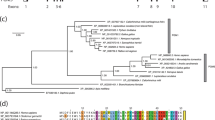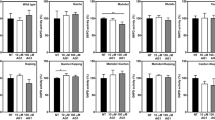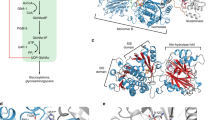Abstract
Phosphofructokinase-1 (PFK1), the ‘gatekeeper’ of glycolysis, catalyses the committed step of the glycolytic pathway by converting fructose-6-phosphate to fructose-1,6-bisphosphate. Allosteric activation and inhibition of PFK1 by over ten metabolites and in response to hormonal signalling fine-tune glycolytic flux to meet energy requirements1. Mutations inhibiting PFK1 activity cause glycogen storage disease type VII, also known as Tarui disease2, and mice deficient in muscle PFK1 have decreased fat stores3. Additionally, PFK1 is proposed to have important roles in metabolic reprogramming in cancer4,5. Despite its critical role in glucose flux, the biologically relevant crystal structure of the mammalian PFK1 tetramer has not been determined. Here we report the first structures of the mammalian PFK1 tetramer, for the human platelet isoform (PFKP), in complex with ATP–Mg2+ and ADP at 3.1 and 3.4 Å, respectively. The structures reveal substantial conformational changes in the enzyme upon nucleotide hydrolysis as well as a unique tetramer interface. Mutations of residues in this interface can affect tetramer formation, enzyme catalysis and regulation, indicating the functional importance of the tetramer. With altered glycolytic flux being a hallmark of cancers6, these new structures allow a molecular understanding of the functional consequences of somatic PFK1 mutations identified in human cancers. We characterize three of these mutations and show they have distinct effects on allosteric regulation of PFKP activity and lactate production. The PFKP structural blueprint for somatic mutations as well as the catalytic site can guide therapeutic targeting of PFK1 activity to control dysregulated glycolysis in disease.
This is a preview of subscription content, access via your institution
Access options
Subscribe to this journal
Receive 51 print issues and online access
$199.00 per year
only $3.90 per issue
Buy this article
- Purchase on Springer Link
- Instant access to full article PDF
Prices may be subject to local taxes which are calculated during checkout




Similar content being viewed by others
References
Schöneberg, T., Kloos, M., Brüser, A., Kirchberger, J. & Sträter, N. Structure and allosteric regulation of eukaryotic 6-phosphofructokinases. Biol. Chem. 394, 977–993 (2013)
Tarui, S. et al. Phosphofructokinase deficiency in skeletal muscle. A new type of glycogenosis. Biochem. Biophys. Res. Commun. 19, 517–523 (1965)
Getty-Kaushik, L. et al. Mice deficient in phosphofructokinase-M have greatly decreased fat stores. Obesity 18, 434–440 (2010)
Yi, W. et al. Phosphofructokinase 1 glycosylation regulates cell growth and metabolism. Science 337, 975–980 (2012)
Moreno-Sánchez, R. et al. Phosphofructokinase type 1 kinetics, isoform expression and gene polymorphisms in cancer cells. J. Cell. Biochem. 113, 1692–1703 (2012)
Hanahan, D. & Weinberg, R. A. Hallmarks of cancer: the next generation. Cell 144, 646–674 (2011)
Dunaway, G. A. A review of animal phosphofructokinase isozymes with an emphasis on their physiological role. Mol. Cell. Biochem. 52, 75–91 (1983)
Evans, P. R., Farrants, G. W. & Hudson, P. J. Phosphofructokinase: structure and control. Phil. Trans. R. Soc. Lond. B 293, 53–62 (1981)
Rypniewski, W. R. & Evans, P. R. Crystal structure of unliganded phosphofructokinase from Escherichia coli. J. Mol. Biol. 207, 805–821 (1989)
Paricharttanakul, N. M. et al. Kinetic and structural characterization of phosphofructokinase from Lactobacillus bulgaricus. Biochemistry 44, 15280–15286 (2005)
Mosser, R., Reddy, M. C. M., Bruning, J. B., Sacchettini, J. C. & Reinhart, G. D. Redefining the role of the quaternary shift in Bacillus stearothermophilus phosphofructokinase. Biochemistry 52, 5421–5429 (2013)
Banaszak, K. et al. The crystal structures of eukaryotic phosphofructokinases from baker’s yeast and rabbit skeletal muscle. J. Mol. Biol. 407, 284–297 (2011)
Sträter, N. et al. Molecular architecture and structural basis of allosteric regulation of eukaryotic phosphofructokinases. FASEB J. 25, 89–98 (2011)
Mcnae, I. W. et al. The crystal structure of ATP-bound phosphofructokinase from Trypanosoma brucei reveals conformational transitions different from those of other phosphofructokinases. J. Mol. Biol. 385, 1519–1533 (2009)
Sánchez-Martínez, C., Estévez, A. M. & Aragon, J. J. Phosphofructokinase C isozyme from ascites tumor cells: cloning, expression, and properties. Biochem. Biophys. Res. Commun. 271, 635–640 (2000)
Ferreras, C., Hernández, E. D., Martínez-Costa, O. H. & Aragón, J. J. Subunit interactions and composition of the fructose 6-phosphate catalytic site and the fructose 2,6-bisphosphate allosteric site of mammalian phosphofructokinase. 284, 9124–9131 (2009)
Rizzo, S. C. & Eckel, R. E. Control of glycolysis in human erythrocytes by inorganic phosphate and sulfate. Am. J. Physiol. 211, 429–436 (1966)
Akkerman, J. W., Gorter, G., Sixma, J. J. & Staal, G. E. Human platelet 6-phosphofructokinase. Purification, kinetic parameters and the influence of sulphate ions on enzyme activity. Biochim. Biophys. Acta 370, 102–112 (1974)
Schirmer, T. & Evans, P. R. Structural basis of the allosteric behaviour of phosphofructokinase. Nature 343, 140–145 (1990)
Hesterberg, L. K. & Lee, J. C. Self-association of rabbit muscle phosphofructokinase: effects of ligands. Biochemistry 21, 216–222 (1982)
Leite, T., Da Silva, D., Coelho, R., Zancan, P. & Sola-Penna, M. Lactate favours the dissociation of skeletal muscle 6-phosphofructo-1-kinase tetramers down-regulating the enzyme and muscle glycolysis. Biochem. J. 408, 123–130 (2007)
Zancan, P., Marinho-Carvalho, M. M., Faber-Barata, J., Dellias, J. M. M. & Sola-Penna, M. ATP and fructose-2,6-bisphosphate regulate skeletal muscle 6-phosphofructo-1-kinase by altering its quaternary structure. IUBMB Life 60, 526–533 (2008)
Telford, J. N., Lad, P. M. & Hammes, G. G. Electron microscope study of native and crosslinked rabbit muscle phosphofructokinase. Proc. Natl Acad. Sci. USA 72, 3054–3056 (1975)
Yalcin, A., Telang, S., Clem, B. & Chesney, J. Regulation of glucose metabolism by 6-phosphofructo-2-kinase/fructose-2,6-bisphosphatases in cancer. Exp. Mol. Pathol. 86, 174–179 (2009)
Moon, J.-S. et al. Krüppel-like factor 4 (KLF4) activates the transcription of the gene for the platelet isoform of phosphofructokinase (PFKP) in breast cancer. J. Biol. Chem. 286, 23808–23816 (2011)
Park, Y.-Y. et al. Tat-activating regulatory DNA-binding protein regulates glycolysis in hepatocellular carcinoma by regulating the platelet isoform of phosphofructokinase through microRNA 520. Hepatology 58, 182–191 (2013)
Forbes, S. A. et al. COSMIC: mining complete cancer genomes in the Catalogue of Somatic Mutations in Cancer. Nucleic Acids Res. 39, D945–D950 (2010)
A map of human genome variation from population-scale sequencing. Nature 467, 1061–1073 (2010)
Reva, B., Antipin, Y. & Sander, C. Predicting the functional impact of protein mutations: application to cancer genomics. Nucleic Acids Res. 39, e118 (2011)
Li, Y., Rivera, D., Ru, W., Gunasekera, D. & Kemp, R. G. Identification of allosteric sites in rabbit phosphofructo-1-kinase. Biochemistry 38, 16407–16412 (1999)
Brüser, A., Kirchberger, J., Kloos, M., Sträter, N. & Schöneberg, T. Functional linkage of adenine nucleotide binding sites in mammalian muscle 6-phosphofructokinase. J. Biol. Chem. 287, 17546–17553 (2012)
Schindelin, J. et al. Fiji: an open-source platform for biological-image analysis. Nature Methods 9, 676–682 (2012)
Otwinowski, Z. & Minor, W. Processing of X-ray diffraction data collected in oscillation mode. Methods Enzymol. 276, 307–326 (1997)
Vagin, A. & Teplyakov, A. Molecular replacement with MOLREP. Acta Crystallogr. 66, 22–25 (2010)
McRee, D. E. XtalView/Xfit–a versatile program for manipulating atomic coordinates and electron density. J. Struct. Biol. 125, 156–165 (1999)
Brünger, A. T. et al. Crystallography & NMR system: a new software suite for macromolecular structure determination. Acta Crystallogr. D 54, 905–921 (1998)
Pettersen, E. F. et al. UCSF Chimera—a visualization system for exploratory research and analysis. J. Comput. Chem. 25, 1605–1612 (2004)
Segall, J. E. et al. EGF stimulates lamellipod extension in metastatic mammary adenocarcinoma cells by an actin-dependent mechanism. Clin. Exp. Metastasis 14, 61–72 (1996)
Lundholm, L., Mohme-Lundholm, E. & Vamos, N. Lactic acid assay with L(+)lactic acid dehydrogenase from rabbit muscle. Acta Physiol. Scand. 58, 243–249 (1963)
Abrantes, J. L. et al. Herpes simplex type 1 activates glycolysis through engagement of the enzyme 6-phosphofructo-1-kinase (PFK-1). Biochim. Biophys. Acta Mol. Basis Dis. 1822, 1198–1206 (2012)
Acknowledgements
We thank S. Oakes for access to FPLC instrumentation, R. Fletterick and K. White for discussions, and A. Lauricella and G. DeTitta for the crystallization screening. This work was supported by National Institutes of Health R01 GM047413 to D.L.B., a Canadian Institutes of Health Research postdoctoral fellowship and a Pilot/Feasibility grant from the University of California, San Francisco, Liver Center (P30 DK026743) to B.A.W., and a grant from the Protein Structure Initiative of the National Institutes of Health U54-GM094597 to L.T.
Author information
Authors and Affiliations
Contributions
B.A.W. and D.L.B. conceived initial studies with recombinant PFKP. B.A.W. expressed and purified recombinant PFKP, and performed thermostability screens to identify buffer conditions for protein stability. Crystal screening hits were extensively optimized by F.E.S. and F.F. J.S. performed X-ray diffraction data collection and processing. F.F. determined and refined the structures. B.A.W. generated and biochemically characterized recombinant WT and mutant PFKP, and generated and analysed cells with heterologous PFKP expression. B.A.W., F.F., L.T. and D.L.B. contributed to writing the manuscript.
Corresponding authors
Ethics declarations
Competing interests
The authors declare no competing financial interests.
Extended data figures and tables
Extended Data Figure 1 Activity of purified recombinant PFKP.
a, Coomassie-stained SDS–polyacrylamide gel electrophoresis (SDS–PAGE) of purified PFKP. The molecular mass (MM) of protein standards is shown in kilodaltons (kDa). b, Allosteric regulation of PFKP by ATP and ADP; F6P saturation curve PFKP in the presence of 0.25 mM ATP (filled black squares), 3 mM ATP (filled grey circles), 0.25 mM ATP and 0.25 mM ADP (open black squares), and 3 mM ATP and 3 mM ADP (open grey circles). c, Effect of ADP on kinetic behaviour of PFKP in the presence of 0.25 mM (black squares) or 3 mM (grey circles) ATP. Data in b and c are means ± s.e.m. of ten (b) or five (c) determinations from two separate protein preparations.
Extended Data Figure 2 Structure, nucleotide binding and phosphate ion binding of PFKP.
a, The structure of PFKP protomer can be divided into two halves: the amino (N)-terminal (cyan) and the carboxy (C)-terminal (yellow) subdomains. The N terminus of each subdomain begins with a nucleotide-binding domain (NBD) followed by a smaller substrate-binding domain (SBD). Each NBD closely resembles a canonical Rossmann fold composed of a seven-stranded β-sheet surrounded by six α-helices. Each SBD consists of a four-stranded β-sheet surrounded by five α-helices. Two phosphate ions (stick drawings) are bound in pockets equivalent to the effector binding sites of the E. coli PFK. b, Final 2Fo − Fc electron density at 3.1 Å resolution for ATP–Mg2+, contoured at 1σ. A strong electron density is observed near β- and γ-phosphate of the nucleotide, which was unambiguously modelled as Mg2+ ion. An extended but weaker electron density is also observed near the γ-phosphate of the nucleotide, which is surrounded by three backbone carbonyls of strictly conserved Ser32, Gly34 and Gly172. This electron density was modelled as a second metal ion, although it may belong to a water molecule. c, d, Structure of the two inorganic phosphate-binding sites in PFKP. e, Plot of concentration of ATP versus relative enzymatic activity of PFKP in the presence (black triangles) and absence (grey circles) of 10 mM sodium sulphate. Activity is expressed relative to maximal activity at this pH and F6P concentration. Data are means ± s.e.m. of three determinations.
Extended Data Figure 3 Structural comparison of the two PFKP tetramers in the ATP–Mg2+ complex.
a, Overlay of the structures of the eight PFKP subunits. Only two loops show substantial differences, indicated with the red arrows. b, Overlay of the two PFKP tetramers. A noticeable difference is the twisting of the second dimer in the two tetramers, indicated with the red arrow.
Extended Data Figure 4 Structural comparison of ATP- and ADP-bound PFKP with R- and T-state of E. coli PFK.
a, Structural overlay of ATP-bound (coloured) and ADP-bound (grey) PFKP. For comparison with structures of E. coli PFK, the N- and C-terminal subdomains of PFKP are coloured cyan and blue for subunit A, and yellow and orange for subunit B. b, The view in a is slabbed to highlight the difference between the two structures. c, Structural overlay of R-state (coloured; PDB accession number 4PFK)11 and T-state (grey; PDB accession number 6PFK)23 of E. coli PFK. d, The view in c is slabbed.
Extended Data Figure 5 A unique tetramer interface in PFKP.
a, Alignment of residues from PFKP surrounding Phe649 (arrow) with human PFKM and PFKL and S. cerevisiae PFK1 α- and β-subunits. b, Structure of PFKP tetramer. c, Structure of ScPFK tetramer15, viewed roughly in the same orientation as PFKP. The tetramer interface is highlighted in the red box. d, Structure of rabbit PFKM15. e, Stereo drawing of the overlay of the tetramer interface of PFKP (in colour) and ScPFK.
Extended Data Figure 6 Purification and TEM analysis of PFKP tetramer mutants.
a, Coomassie-stained SDS–PAGE of PFKP F649L and E657A. b, c, TEM images of PFKP F649L (b) in buffer with activator and substrates (3 mM ADP, 3 mM ATP and 8 mM F6P) and WT PFKP (c) in buffer containing inhibitor (1 mM citrate). Red arrows indicate dimers. Scale bar, 50 nm. d, Activity of WT PFKP and PFKP-F649L in buffer containing 3 mM ADP, 3 mM ATP and 8 mM F6P. Data are means ± s.e.m. of six (WT) and nine (F649L) determinations from two independent protein preparations (P < 0.001).
Extended Data Figure 7 Purification of PFKP cancer mutants and their activity in cells.
a, Coomassie-stained SDS–PAGE of purified recombinant PFKP mutants R48C, N426S and D564N. b, Immunoblot of GFP and actin from total cell lysates of MTLn3 rat mammary adenocarcinoma cells expressing PFKP–GFP. Blots are representative of three experiments from individual preparations of cells. c, PFK1 activity (micromoles of F1,6bP produced per minute per nanogram of total cell lysate) was measured in five independent preparations of cells. A two-sided paired t-test was used to determine significance. **P < 0.01; ***P < 0.001.
Supplementary information
Conformational change in PFKP upon ATP hydrolysis
The trajectory between the ATP-Mg2+-bound and the ADP-bound structures, viewed at the catalytic interface. (MOV 2172 kb)
Conformational change in PFKP upon ATP hydrolysis
The trajectory between the ATP-Mg2+-bound and the ADP-bound structures, viewed at the tetramer interface. (MOV 2830 kb)
Rights and permissions
About this article
Cite this article
Webb, B., Forouhar, F., Szu, FE. et al. Structures of human phosphofructokinase-1 and atomic basis of cancer-associated mutations. Nature 523, 111–114 (2015). https://doi.org/10.1038/nature14405
Received:
Accepted:
Published:
Issue Date:
DOI: https://doi.org/10.1038/nature14405
This article is cited by
-
Integrative proteogenomic characterization of early esophageal cancer
Nature Communications (2023)
-
How protons pave the way to aggressive cancers
Nature Reviews Cancer (2023)
-
Liver Transcriptome Analysis Reveals Energy Regulation and Functional Impairment of Onychostoma sima During Starvation
Marine Biotechnology (2023)
-
Coenzyme Q0 defeats NLRP3-mediated inflammation, EMT/metastasis, and Warburg effects by inhibiting HIF-1α expression in human triple-negative breast cancer cells
Archives of Toxicology (2023)
-
Autoregulation of H+/lactate efflux prevents monocarboxylate transport (MCT) inhibitors from reducing glycolytic lactic acid production
British Journal of Cancer (2022)
Comments
By submitting a comment you agree to abide by our Terms and Community Guidelines. If you find something abusive or that does not comply with our terms or guidelines please flag it as inappropriate.



